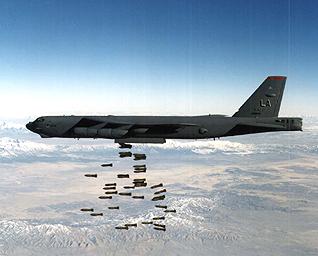Bombing Our Way to Peace? Afghanistan 2010 and Vietnam 1972
 UPDATE 1015 GMT: Fred Kaplan of Slate also puts out the military's message:
UPDATE 1015 GMT: Fred Kaplan of Slate also puts out the military's message:
"Petraeus is unleashing the special-ops guys," one U.S. official told me, in every area of Afghanistan where the Taliban are in force: north, east, and south. It's not just special-ops troops. According to the latest unclassified Air Force data, U.S. warplanes and drones dropped or fired 1,600 weapons on Afghan targets in the last three months, nearly half of them—700—in September alone. In the same three months last year, just 1,031 aerial weapons were released, 257 of them in that September.
Kaplan, however, is even more blatant than Filkins in his fretting: "The path to the end of this war is suddenly a bit clearer, but how this thing ends and what happens afterward remain as murky as ever."
---
So here is the attention-grabbing news in The New York Times, courtesy of reporter Dexter Filkins: Airstrikes on Taliban insurgents have risen sharply here over the past four months, the latest piece in what appears to be a coordinated effort by American commanders to bleed the insurgency and pressure its leaders to negotiate an end to the war. American pilots pounded the Taliban with 2,100 bombs or missiles from June through September, with 700 in September alone, Air Force officers here said Thursday. That is an increase of nearly 50 percent over the same period last year, the records show. The stepped-up air campaign is part of what appears to be an intensifying American effort, orchestrated by Gen. David H. Petraeus, to break the military stalemate here as pressure intensifies at home to bring the nine-year-old war to an end. In recent weeks, General Petraeus has increased raids by Special Forces units and launched large operations to clear territory of Taliban militants. And it seems increasingly clear that he is partly using the attacks to expand a parallel path to the end of the war: an American-led diplomatic initiative, very much in its infancy but ultimately aimed at persuading the Taliban — or large parts of the movement — to make peace with the Afghan government. In recent weeks, American officials have spoken approvingly in public of new contacts between Taliban leaders and the Afghan government. On Wednesday they acknowledged their active involvement by helping Taliban leaders travel to Kabul to talk peace. For most of the story, Filkins is a reliable channel for the military line, but in the final paragraphs, he strays from the narrative of Peace Through Bombing: General Petraeus appears to be following a template that helped him pull the Iraq war back from the cataclysmic levels of violence that engulfed the country after the American invasion. Beginning in 2006, American commanders simultaneously opened negotiations with insurgent leaders while killing or capturing those not inclined to make a deal. Afghanistan is a different country, and it is not clear that the tactics that brought success in Iraq will work here. In particular, the Afghan insurgency is nowhere near to being as cohesive as the insurgency in Iraq, where guerrilla leaders could order their men to stop fighting with a reasonable expectation that they would obey. Some Afghan experts believe that NATO’s two-track strategy is flawed — that bleeding the Taliban may actually make the insurgents less inclined to negotiate. Matt Waldman, an independent analyst who has worked extensively in the region, said that it was unlikely that many Taliban leaders could order their men to stop fighting. “It’s dangerous to assume that you can bring off a senior commander and all his men will follow,” Mr. Waldman said. It was more likely, he said, that the midlevel commanders now being killed by NATO would be replaced by others ever more committed to fighting. After all, one of the principles of the Afghan campaign, enunciated by General Petraeus himself and Gen. Stanley A. McChrystal before him, was that NATO would never be able to kill and capture its way to victory. “The idea that killing insurgents will take us to negotiations seems pretty doubtful,” Mr. Waldman said. “They have an infinite capacity to regenerate.” All solid points, but my initial reaction to Filkins' article came from events almost 40 years ago. An academic study by Trong Q. Phan states concisely: "Operation Linebacker II..., ordered by President Nixon, lasted 11 days (18-29 December 1972). The primary objective of the operation was to coerce North Vietnam to re-enter into purposeful negotiations concerning a peace agreement that helped end the war in terms acceptable to the US." Well, there was a peace agreement between representatives of North Vietnam and South Vietnam on 27 January 1973. But I seem to recall that this was not the end of the story....

 Friday, October 15, 2010 at 11:00
Friday, October 15, 2010 at 11:00
Reader Comments